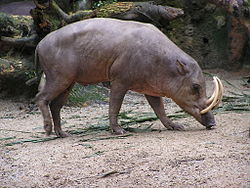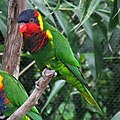Sulawesi
Sulawesi (formerly known as Celebes) is one of the four larger Sunda Islands of Indonesia, and is between Borneo and the Maluku Islands.
Geography
Sulawesi is the world's eleventh-largest island, covering an area of 174,600 km2. The island is surrounded by Borneo to the west, by the Philippines to the north, by Maluku to the east, and by Flores and Timor to the south. It has a distinctive shape, dominated by four large peninsulas: the Semenanjung Minahassa; the East Peninsula; the South Peninsula; and the South-east Peninsula. The central part of the island is ruggedly mountainous, such that the island's peninsulas have traditionally been remote from each other, with better connections by sea than by road.
Major cities
These are the ten largest cities in Sulawesi by population in 2010.[1]
| City, Province | Population |
|---|---|
| Makassar, South Sulawesi | 1,339,374 |
| Manado, North Sulawesi | 675,354 |
| Kendari, Southeast Sulawesi | 289,153 |
| Palu, Central Sulawesi | 335,297 |
| Gorontalo, Gorontalo | 1,097,990 |
| Bitung, North Sulawesi | 387,932 |
| Palopo, South Sulawesi | 148,033 |
| Baubau, Southeast Sulawesi | 137,118 |
| Parepare, South Sulawesi | 129,542 |
| Kotamobagu, North Sulawesi | 107,216 |
Sulawesi Media
Mount Tongkoko is a volcano in North Sulawesi
Stencils of right hands in Pettakere Cave in Maros are among the oldest known examples of human artwork
Toraja burial site. Tau-tau, the statue representing the buried people, can be seen in niches on the cliff.
The colorful bark of Eucalyptus deglupta
The north Sulawesi babirusa is endemic to Sulawesi.
The endemic ornate lorikeet
References
- ↑ "Indonesia: Provinces, Cities & Municipalities". City Population. Retrieved 2010-04-28.










